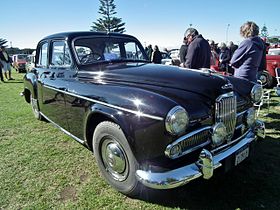Humber Super Snipe
| Humber Super Snipe | |
|---|---|

Humber Super Snipe Series II
|
|
| Overview | |
| Manufacturer | Humber (Rootes Group) |
| Production | 1938-1967 |
| Assembly |
United Kingdom Australia, New Zealand |
| Body and chassis | |
| Related |
Humber Hawk Humber Snipe Humber Pullman Humber Imperial |
| Humber Super Snipe | |
|---|---|
 |
|
| Overview | |
| Production | 1938-1940 1500 (approx) made |
| Body and chassis | |
| Body style | 4-door saloon Sports saloon Drophead coupé |
| Powertrain | |
| Engine | 4086 cc Straight-6 side valve |
| Dimensions | |
| Wheelbase | 114 in (2,896 mm) |
| Length | 175 in (4,445 mm) |
| Width | 70 in (1,778 mm) |
| Chronology | |
| Predecessor | Humber Snipe |
| Humber Super Snipe Mark I-III | |
|---|---|

Humber Super Snipe 1951 ex military
|
|
| Overview | |
| Production | 1945-1952 production 3909 (Mk I) 8,361 (Mk II) 8,703 (Mk III) |
| Body and chassis | |
| Body style | 4-door saloon drophead coupe estate car |
| Powertrain | |
| Engine | 4086 cc Straight-6 side valve (I to III) |
| Dimensions | |
| Wheelbase | 114 in (2,896 mm) (I) 117 in (2,972 mm) (I to III) |
| Length | 180 in (4,572 mm) (I) 187 in (4,750 mm) (II) 191 in (4,851 mm) (III) |
| Width | 69 in (1,753 mm) (I) 74 in (1,880 mm) (II & III) |
| Humber Super Snipe Mark IV | |
|---|---|

1955 example
|
|
| Overview | |
| Production | 1952-1958 production 17,993 (IV) |
| Body and chassis | |
| Body style | 4-door saloon |
| Powertrain | |
| Engine | 4138 cc Straight-6 ohv |
| Transmission | 4-speed manual |
| Dimensions | |
| Wheelbase | 116 in (2,946 mm) |
| Length | 197 in (5,004 mm) |
| Width | 71 in (1,803 mm) |
| Height | 54 in (1,400 mm) |
| Humber Super Snipe Series I-V | |
|---|---|

Series V registered July 1966
|
|
| Overview | |
| Production | 1958-1967 production 6,072 (I) 7,175 (II) 7,257 (III) 6,495 (IV) 3,032 (V) |
| Body and chassis | |
| Body style | 4-door saloon Estate car limousine |
| Powertrain | |
| Engine | 2651 cc Straight-6 ohv (I) 2965 cc ohv (II-V) |
| Transmission | 3 speed manual Overdrive and automatic optional |
| Dimensions | |
| Wheelbase | 110 in (2,794 mm) |
| Length |
|
| Width |
|
| Height | 62 in (1,575 mm) |
| Kerb weight | 3,584 lb (1,625 kg) (S. III Estate) |
The Humber Super Snipe is a car which was produced from 1938 to 1967 by British-based Humber Limited.
The Super Snipe was introduced in October 1938, derived by combining the four-litre inline six-cylinder engine from the larger Humber Pullman with the chassis and body of the Humber Snipe, normally powered by a three-litre engine. The result was a car of enhanced performance and a top speed of 79 mph (127 km/h) —fast for its day. Its design was contributed to by American engine genius Delmar "Barney" Roos who left a successful career at Studebaker to join Rootes in 1936.
The Super Snipe was marketed to upper-middle-class managers, professional people and government officials. It was relatively low-priced for its large size and performance, and was similar to American cars in appearance and concept, and in providing value for money.
Within a year of introduction, World War II broke out in Europe but the car continued in production as a British military staff car, the Car, 4-seater, 4x2, while the same chassis was used for an armoured reconnaissance vehicle, the Humber Light Reconnaissance Car.
In 1946, post-war civilian production resumed and the Super Snipe evolved though several versions, each designated by a Mark number, each generally larger, more powerful, and more modern, until production ended in 1957 with the Mark IVB version.
The Mark I was essentially a 6-cylinder version of the 1945 Humber Hawk, itself a facelifted pre-war car. A version of the 1930s Snipe remained available, with the 1936-introduced 2731 cc engine. However, the standard Super Snipe engine was the 4086cc side-valve engine that had appeared in the Humber Pullman nearly a decade earlier, in 1936, and which would continue to power post-war Super Snipes until 1952. Throughout the years 1936–1952 the maximum power output of the engine was always given by the manufacturer as 100 bhp at 3400 rpm.
The Mark II announced in mid-September 1948 was mostly redesigned in chassis and body. Now a full six-seater with a bench-type front seat it was given a wider track and a variable ratio steering unit. The gear lever was now mounted on the steering column. Like Humber's Pullman the headlights were fitted into the wings and running-boards were re-introduced. The transverse-spring independent suspension, first introduced on the Snipe and Pullman in 1935, continued but with 14 leaves instead of eight.
...
Wikipedia
